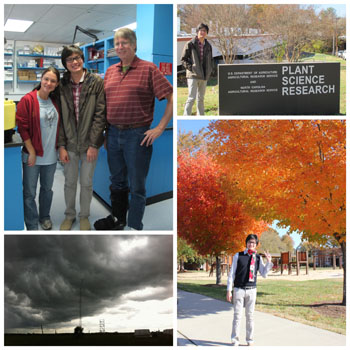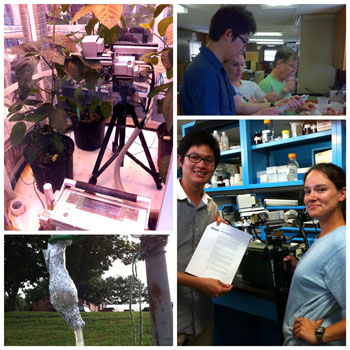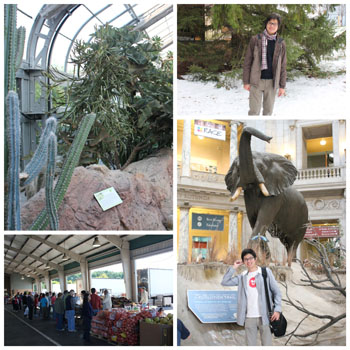Report
Internship: U.S. Department of Agriculture, Agricultural Research Service –A Study of Air Pollution and Crop Physiology
Host: U.S. Department of Agriculture, Agricultural Research Service, Plant Science Research Unit, Raleigh, North Carolina, USADuration: 23 August – 23 November 2011 A Study of Air Pollution and Crop Physiology in the USDA Plant Science Research Unit,
NC State University Prathomrak NA-NGERN
Department of International Environmental Agricultural Science Graduate School of Agriculture
Key words: ozone, air pollution, soybean, photosynthesis, chlorophyll fluorescence
 |
| Figure 1 (A) Left to right: Erin Silva (plant physiologist), me, Professor Dr. Fitzgerald Booker; (B) the sky on the evening before Hurricane Irene hit Raleigh; (C) the Plant Science Research unit; (D) autumn in Raleigh. |
 |
| Figure 2 (A) Soybean photosynthesis and chlorophyll fluorescence measurement using an LI-6400XT machine; (B) atmospheric peroxides measurement; (C) plant biochemistry analysis practice; (D) LI-6400XT skill training with Erin Silva. |
 |
| Figure 3 (A) A US Botanical Garden plant greenhouse (desert plants); (B) the farmer market in Raleigh; (C) snow in Minnesota (my transition airport); (D) the Natural History Museum in Washington, DC. |
1. Contents and activities during the internship
1.1) Internship: location and general information (Figure 1)
I carried out my FOLENS internship at the USDA (United State Division of Agriculture) Plant Science Research unit, North Carolina State University, in Raleigh, USA. This organization is very interesting, and it is a peaceful place to carry out research. Professor Dr. Fitzgerald Booker is head of the Plant Science Research Laboratory, which specializes in soybean physiology and ozone stress in plants. He helped to greatly increase my knowledge in this area.
My internship ran from 23 August to 21 November 2011. During this internship period the seasons changed from summer in late August to fall in November. As indicated in the title of my internship, I wanted to study air pollution, and meteorology is an important factor in this. It was therefore a good chance to study and experience the seasons and weather changing on the American continent. In addition to the seasonal changes, there was an extreme weather event in the form of Hurricane Irene. Irene hit the town of Raleigh, mainly on the coastal side, in late August 2011, which was the first week of my internship. That was one of the most significant experiences of my student life.
1.2) Activities during the internship (Figure 2)
I. Photosynthesis and chlorophyll fluorescence
Currently, the effects on agricultural production of global environmental problems such as water, soil and air pollution are much discussed. Agriculture plays an important role in providing food for an increasing world population. One of the main methods for estimating the efficiency of crop yield is photosynthesis measurement and chlorophyll fluorescence, using the LI-6400XT machine.
In this internship I studied the effect of ozone (O3) on the photosynthetic efficiency of two genotypes of soybeans. The objectives of this research were to study the photosynthetic physiology and chlorophyll fluorescence of soybean plants exposed to an O3 environment, and to see whether the ethylene-producing inhibitor 1-MCP (1-methylcyclopropane) can mitigate the negative effects of O3. I transplanted two genotypes of American soybean plants, the cultivars Fiskeyby (an ozone-tolerant genotype) and Mandarin Ottawa (an ozone-sensitive genotype), during the first period of my internship. These soybean plants were fumigated with O3 in the plant growth chamber of a greenhouse, and 1-MCP was applied using a spray technique at a suitable time. After this, I measured photosynthesis physiology and chlorophyll fluorescence using an LI-6400XT machine.
During my work, with supervision from and the support of USDA plant researchers, I received a lot of new ideas by sharing knowledge with them. For example, I had the opportunity to work with one of the soybean researchers, Dr. Erin Silva, who taught me how to operate the LI-6400XT machine. I was able to study it and take real measurements, both outside and inside the laboratory. As a result, during this internship I learned a lot and applied this knowledge to improve my skills. I absorbed as much as I could in order to improve my career and to be a good environmental leader in the near future.
II. Atmospheric peroxide measurement
As global warming shows, human activities can influence climate processes, generate many pollutants and destroy valuable natural resources. One of the big global environmental problems is air pollution. Many air pollutants such as O3, sulfur dioxide (SO2), carbon monoxide (CO), nitrogen oxides (NOX) and volatile organic compounds (VOCs) are emitted by human activities and affect the environment. Moreover, the new and unfamiliar class of air pollutants, the peroxides, are ubiquitous in nature because they are a primary end product of free-radical reactions involving oxygen and water. The simplest stable peroxides are hydrogen peroxide, superoxide and dioxygenyls. Some research has revealed that peroxide is very harmful to plants when combined with O3, but there is still a lack of basic information and studies in this area.
In this internship, my coordinator and I started to monitor peroxide concentrations in the atmosphere of Raleigh, NC, USA. In order to collect the samples of atmospheric peroxides, meteorological data and atmospheric O3 concentrations were necessary in order to interpret the concentrations of atmospheric peroxides. Professor Dr. Fitzgerald Booker and the scientific technician helped us to set up the atmospheric O3 and peroxides measurement column near our internship work site. Every second week the peroxides sample solutions were collected five times per day, 4 days continuously. These solutions were analyzed using an RQflex10 machine to measure the atmospheric peroxides concentration. The results showed that the concentrations of atmospheric peroxides can be expected to increase in the near future.
III. Plant biochemical analysis techniques
In order to carry out in-depth study of plants’ responses to physiological stress, knowledge of and techniques relating to plant biochemistry are very important. When crops experience stress in the environment (in this case, O3 in the atmosphere), this stress leads to a decline in crop yield. Combined with air pollutants, which are still increasing globally, the result is many negative impacts on agricultural production and the environment (for example, biodiversity loss, forest decline and acid rain).
One of the best ways to see how plants respond metabolically to stress is to use plant biochemical techniques. In this internship I learned the basics of plant biochemistry analytical techniques for ethylene (C2H4), peroxides in plant cells, and dimethylamino-fluorene (DAF). These parameters can be used to determine the growth and response of plants under air pollution stress. For example, C2H4 analysis is used to determine the amount of C2H4 released from soybean leaves, using gas chromatography (GC). Plant physiologists usually consider C2H4 to be one of the plant hormones that can be used to estimate the stress on plants. Unlike other plant hormones, C2H4 is a volatile gas that is readily given off to the atmosphere. I gained not only knowledge of C2H4 analysis but also the practical techniques for using the GC machine.
IV. Other activities (Figure 3)
During my internship period, along with laboratory work I also enjoyed a number of other activities. For example, I went to the United States Botanic Garden in Washington, DC, which has a huge variety of native and exotic plant species. There are many plant greenhouses there, which are used to display various kinds of plants from a plant ecology point of view. For example, the desert plants greenhouse had many species of cactus and succulent plants; the primeval plants greenhouse displayed the lower vascular plants such as mosses, ferns and cycads; and the rare and endangered species plant greenhouse gave information about the endangered plant species in America, and also propagated and grew them in order to increase their population.
I also went to the NC state fair, which was held during my internship period. It was very interesting. The NC state fair is held once a year to present innovations and products relating to agriculture and technology in NC state. There were many activities and different kinds of exhibits; for example, there was a soil and water conservation exhibit, where people could talk to soil and water specialists in order to learn more about the importance of soil and the soil ecosystem. The NC Forest Service exhibit focused on explaining how to help keep the forests alive and well, and was giving away tree seedlings to people to enhance tree distribution.
Finally, I visited many interesting places located not far from my work place, such as museums, a traditional farmer market and the local natural park.
2. Experiences and achievements gained from the internship
2.1) Scientific experiences and achievements
The USA is a one of the world’s leading countries, and the USDA is one of the world’s best-known organizations for agricultural production and technology. In this internship I learned a lot about scientific and laboratory work, especially in relation to soybeans, because my internship laboratory focused on soybean production. There are many soybean laboratories at the unit, and each laboratory has a different focus in soybean research. Some laboratories study soybean genetic improvement, some focus on soybean pest control, and others research post-harvest technology for soybeans. Professor Dr. Fitzgerald Booker’s laboratory (my host laboratory) mainly researches air pollution, and in particular the effect of O3 on soybeans. I therefore learned a lot of new theory and practical techniques, which will be very important and useful for conducting and improving my research and my career, because it was all new to me. In this report, I will briefly look at one technique: chlorophyll fluorescence.
Photosynthesis is a necessary part of plants’ metabolism in their life cycle. Without this activity, individual plants cannot survive in nature. Plants use sunlight to oxidize water and carbon dioxide (CO2), thereby forming large carbon compounds (to produce their food starch or sugar) via chlorophylls in the plant’s organs, mostly in leaves with a green color. When sunlight shines through plant leaves, one of three things can happen to the light: it may be used in photochemistry; it may be emitted as heat; or the excited chlorophyll may emit a photon and thereby return to its ground state of energy level; this process is called fluorescence. Most fluorescence is emitted by chlorophyll a of PhotosystemII (PSII), which plant physiologists usually call chlorophyll fluorescence. Fluorescence increases when photochemistry and/or dissipation are low relative to photon absorption, but the process is not regulated as such. It can occur under conditions of excessive light, a severely limiting CO2 supply, or stresses that inhibit photochemistry. Therefore many parameters of chlorophyll fluorescence are used to estimate the photosynthetic efficiency of normal plants, and plants that grow under abiotic or biotic stress conditions, as in a high O3 environment. For example, Fv/Fm, which gives the maximum quantum yield after dark incubation, is typically very stable, with a value of around 0.8 in healthy leaves. My experimental results confirmed that in soybeans that were fumigated with 70 ppbv O3 in the growth chamber for 4 days continuously, the Fv/Fm value was lower than 0.8 (around 0.5−0.6). This indicates that plants decrease their use of sunlight for photochemistry and release more fluorescence, which implies that O3 pollution can effectively decrease the photosynthetic ability of soybeans within a short period.
2.2) Intercultural experiences and achievements
Everybody knows that American culture is different from Asian culture, including the language, foods, traditions, manners and social relations. During this internship I learned a lot about American ways of life. One of the important things I learned from this internship related to the organization and management of daily working life. Because the USDA is one of the science offices, every officer has to work on weekdays from 9:00 to 17:00. This was the first time I had worked in a government office with plant researchers, and I learned that responsibility and duty are very important things for work. American people mainly stay at work only during work time, which means that after 17:00 on weekdays most officers will return home and continue their work for the next day. This work style seemed very different from the Japanese style, which usually involves working overtime and sometimes also during the holidays.
I also learned about organizational management. Twice I had the opportunity to attend the work project’s meeting. I could not understand the details they discussed, but I was able to see how they share their ideas and how they assign and manage the projects.
3. Relationship of the internship experience to future career development as a field-oriented leader in Asia and Africa
The experiences I gained from this internship will influence my way of thinking and will help generate ideas about environmental issues, not only from the plant physiologist’s perspective but also from other points of view, such as American children, housekeepers, and also Thai students who study in America. In other words, I shared and exchanged opinions on global environmental topics both inside academic departments and in the wider society. In my opinion, the theory and knowledge we have acquired is still not enough to fulfill today’s requirements for society. The world still needs a new and powerful generation in order to heal the environment, and to work to solve issues and develop both society and the environment. This means that real experiences are very important. In my case, I believe that I can use and integrate the valuable experiences I gained from this internship for my future career and become like FOLENs, who have tools (called theories) and power (called experiences and practices). I believe that I can lead and help current global environmental problems using these tools and power. However, in order to be a field-oriented leader, I have to try to use and enhance my skills and share these skills with others in my home country and internationally in the future.
Lastly, I would like to express my gratitude to the Education Program for Field-Oriented Leaders in Environmental Sectors in Asia and Africa, Tokyo University of Agriculture and Technology, for furnishing the internship’s scholarship and providing me with the chance to gain a lot of new knowledge and have new experiences, especially relating to air pollution on plant production. My gratitude also extends to Prof., Dr. Masatoshi AOKI, Prof., Dr. Fitzgerald Booker, the USDA plant science research unit officers in Raleigh, and all the FOLENS staff for recommending and supporting this internship from start to successful completion.